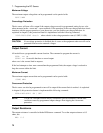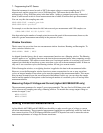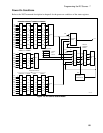
Programming the DC Source - 7
79
Returning All Measurement Data From the Data Buffer
The MEASure:ARRay and FETCh:ARRay queries return all data values of the instantaneous voltage or
current buffer. No weighting function is applied, returning only raw data from the buffer. The commands
are:
MEAS:ARR:CURR?
MEAS:ARR:VOLT?
Making DVM Measurements
Agilent Models 66321D and 66319D have a DVM input on the rear panel for making independent
voltage measurements. The common mode voltage range of the DVM is −4.5 V to +25 V from either
DVM input with respect to the negative output terminal of output 1. To protect the DVM from damage,
keep the maximum isolation voltage to ground at less than ±50 Vdc. To obtain correct voltage
measurements, keep the common mode voltage within the specified limits. Refer to chapter 3 under
"DVM Connection" for more information.
The DVM can only measure average and rms voltage. Its measurement parameters are not programmable.
They are fixed at 2048 data points with a 15.6 microsecond sampling rate using a Hanning window. Use
the SCPI language MEASure and FETCh queries to return measurements. Note that all triggered
measurement functions discussed the next section also apply to DVM measurements.
NOTE: There is only one measurement system in the dc source. Therefore, you can perform only
one measurement function (voltage, current, or DVM) at a time.
Average Measurements
To measure the average voltage, use:
MEAS:DVM:DC?
Average voltage measured by acquiring a number of readings at the selected time interval, applying a
Hanning window function to the readings, and averaging the readings. Windowing is a signal
conditioning process that reduces the error in average measurements made in the presence of periodic
signals. The DVM sampling rate and sweep size result in a data acquisition time of 32 milliseconds per
measurement. Adding a command processing overhead of about 20 milliseconds results in a total
measurement time of about 50 milliseconds per measurement.
RMS Measurements
To measure rms voltage, use:
MEAS:DVM:ACDC?
This returns the total rms measurement. If ac and dc are present, the DVM measures the total rms of
ac+dc.
Making rms or average measurements on ac waveforms for which a non-integral number of cycles of data
has been acquired may result in measurement errors due to the last partial cycle of acquired data. This
error is reduced by using a Hanning window function when making the measurement.


















